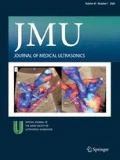Abstract
Purpose
To clarify whether the use of laparoscopic ultrasound (LUS) during laparoscopic myomectomy could reduce the number of residual myomas after surgery.
Methods
A cohort study was conducted. Subjects were women who underwent laparoscopic myomectomy for multiple uterine myomas for the first time. The subjects were assigned to one of two groups: LUS group or non-LUS group. All subjects underwent pelvic MRI 3 months before and 6 months after surgery, and the number of myomas on MRI was counted by radiodiagnosticians. The extraction rate and residual rate of uterine myomas were compared between the two groups.
Results
Fourteen cases with and 30 cases without LUS were analyzed. Median operation times were 171 min (range 75–295) and 141 min (range 50–260) in cases with and without LUS, respectively (p = 0.077). Median extraction rates relative to the total number of myomas were 106 % (range 75–147 %) in subjects with LUS and 100 % (range 71–233 %) in subjects without LUS (p = 0.480). Numbers of residual myomas were 1 (range 0–3) in subjects with LUS and 2 (range 0–9) in subjects without LUS (p = 0.028). Median residual rates of myomas were 6.1 % (range 0–20 %) in subjects with LUS and 20.0 % (range 0–69 %) in subjects without LUS (p = 0.048). Myomas greater than 3 cm in diameter were not observed in either group.
Conclusions
The number and residual rate of myomas were significantly less in subjects with LUS as compared with those without LUS.





Similar content being viewed by others
References
Bettocchi S, Siristatidis C, Pontrelli G, et al. The destiny of myomas: should we treat small submucous myomas in women of reproductive age? Fertil Steril. 2008;90:905–10.
Andersen J. Growth factors and cytokines in uterine leiomyomas. Semin Reprod Endocrinol. 1996;14:269–82.
Peddada SD, Laughlin SK, Miner K, et al. Growth of uterine leiomyomata among premenopausal black and white women. Proc Natl Acad Sci USA. 2008;105:19887–92.
Nishiyama S, Saito M, Sato K, et al. High recurrence rate of uterine fibroids on transvaginal ultrasound after abdominal myomectomy in Japanese women. Gynecol Obstet Investig. 2006;61:155–9.
Malone LJ. Myomectomy: recurrence after removal of solitary and multiple myomas. Obstet Gynecol. 1969;34:200–3.
Lin PC, Thyer A, Soules MR. Intraoperative ultrasound during a laparoscopic myomectomy. Fertil Steril. 2004;81:1671–4.
Seracchioli R, Rossi S, Govoni F, et al. Fertility and obstetric outcome after laparoscopic myomectomy of large myomata: a randomized comparison with abdominal myomectomy. Hum Reprod. 2000;15:2663–8.
Rossetti A, Sizzi O, Soranna L, et al. Long-term results of laparoscopic myomectomy: recurrence rate in comparison with abdominal myomectomy. Hum Reprod. 2001;16:770–4.
Marret H, Chevillot M, Giraudeau B, et al. A retrospective multicentre study comparing myomectomy by laparoscopy and laparotomy in current surgical practice. What are the best patient selection criteria? Eur J Obstet Gynecol Reprod Biol. 2004;117:82–6.
Fedele L, Vercellini P, Bianchi S, et al. Treatment with GnRH agonists before myomectomy and the risk of short-term myoma recurrence. Br J Obstet Gynaecol. 1990;97:393–6.
Gigot JF, Glineur D, Santiago, et al. Laparoscopic liver resection for malignant liver tumors: preliminary results of a multicenter European study. Ann Surg. 2002;236:90–7.
Belli G, Fantini C, D’Agostino, et al. Laparoscopic liver resections for hepatocellular carcinoma (HCC) in cirrhotic patients. HPB Oxf. 2004;6:236–46.
Author information
Authors and Affiliations
Corresponding author
Ethics declarations
Conflict of interest
The authors have no conflict of interest or financial ties to disclose.
Ethical approval
All procedures followed were in accordance with the ethical standards of the responsible committee on human experimentation (institutional and national) and with the Helsinki Declaration of 1975, as revised in 2008.
Informed consent
Informed consent was obtained from all patients for being included in the study.
About this article
Cite this article
Mimura, T., Hasegawa, J., Ishikawa, T. et al. Laparoscopic ultrasound procedure can reduce residual myomas in laparoscopic myomectomy for multiple myomas. J Med Ultrasonics 43, 407–412 (2016). https://doi.org/10.1007/s10396-016-0714-0
Received:
Accepted:
Published:
Issue Date:
DOI: https://doi.org/10.1007/s10396-016-0714-0




